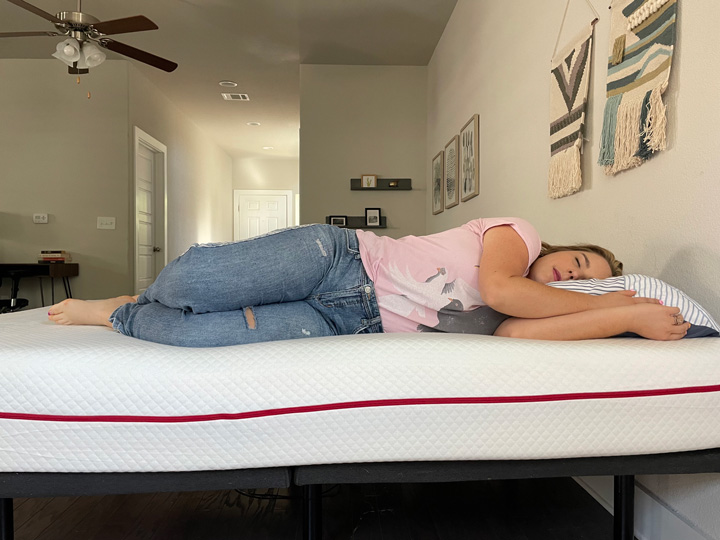Have you read that side sleeping is better for your health and sleep life in comparison to sleeping on your stomach? Like sleeping flat on your back, side sleeping offers great benefits including proper spinal alignment, increased blood flow, and improved digestion. Are you looking to start sleeping on your side, but don’t know how to make that change? Read on to learn how to sleep on your side!
Benefits of Sleeping on Your Side
Back Pain Relief
You may know that the right mattress is important for relieving back pain, but did you know the position you sleep in is also important? Sleeping on your side or back allows the spine to rest in its proper alignment while you peacefully slumber.
UC San Diego Health advises that “sleeping on your side with knees slightly bent upward (but not full fetal position) can help minimize strain on back, neck and spine.” Use a pillow between your legs and any other gaps between you and the mattress so your spine can align parallel to the mattress.
Improved Gut Health
Sleeping on your side can improve your gastrointestinal health. Research shows that lying on your back causes gas to take longer clearing your system. This can lead to symptoms such as constipation and bloating. Side sleeping, on the other hand, is shown to help relieve acid reflux and aid in digestion. In particular, sleeping on your left side may be best for gut health and reflux relief.
Lower Risk of Snoring
Airway obstruction causes snoring and sleep apnea — a common problem when sleeping on your back. According to Keck Medicine of USC, side sleeping is “a good position for snorers or anyone with sleep apnea because it keeps your airways open.”
By sleeping on your side, you not only save your sleep partner a lot of frustration — you get the benefits of more restful sleep. Snoring and sleep apnea cause frequent nighttime wakings in the snorer, which negatively impacts sleep quality and how rejuvenated you feel come morning.

Improved Brain Health
If you wake up feeling groggy and unrefreshed, your sleep position might be to blame. While we sleep, our brains clear out waste. Recent animal research suggests that our brains flush this waste out better when we sleep on our sides than on our backs. This water removal may impact the development of neurological conditions like Parkinson’s and Alzheimer’s.
Improved Blood Flow
According to W. Christopher Winter, MD, Medical Director of the Martha Jefferson Hospital Sleep Medical Center, “sleeping on your left side with your right side not squished is supposed to potentially increase blood flow back to your heart.” But be cautious, as Winter asserts that sleeping on your right side has the opposite effect.
Safe Sleep During Pregnancy
Medical professionals advise against sleeping on your back during pregnancy, to the extent possible. Back sleeping while pregnant can exacerbate back pain and make breathing more difficult. Even more concerning, back sleeping may cause the fetus to put too much pressure on the vein that returns blood to the mother’s heart.
While it’s not the end of the world if you end up on your back here and there while tossing and turning, side sleeping is the best sleep position during pregnancy. Doctors recommend lying on the left side because it improves blood flow — increasing the rate at which oxygen and nutrients reach the fetus. It also keeps pressure off of the mother’s liver.
Wrinkle Prevention
Side sleeping is better than stomach sleeping for preventing wrinkles, although back sleeping is best if your primary concern is wrinkles. According to a study published in the Aesthetic Surgery Journal, “sleep wrinkles develop in response to distortion created when the face is pressed against any sleep surface.” So the less of your face that’s squished against your pillow, the fewer wrinkles you’ll see in the coming years.
How to Sleep on Your Side
Put a Pillow Between Your Knees
Side sleeping can be great for back pain, but only if you maintain proper spinal alignment. To do this, place a thin pillow between your knees. This helps align your spine properly and keeps you from rotating into less ideal positions during the night.
To determine the best pillow to use, ask someone to look at the shape your spine makes while you lay on your side. Ideally, your spine should appear straight and your shoulders and hips should be parallel.
Don’t Rest on Your Arm
Circulation is improved when side sleeping — unless you crush the veins in your arm. Unfortunately, that’s exactly what happens when you rest too much of your body weight on your bottom arm when side sleeping. This pressure also compresses nerves, which can cause you to wake up with a twinge in your arm, or exacerbated carpal tunnel symptoms.
If possible, sleep with both arms out slightly in front of your body — this way, your top arm isn’t putting pressure on your kidney, and your bottom arm isn’t getting crushed. You can use a pillow in much the same way as you would between your knees to support your top arm. Hugging a pillow between your arms also helps you stay in proper side-sleeper alignment.
Make Sure Your Pillow Works for Side Sleeping
If you’re used to sleeping on your back or stomach, your pillow is probably too thin for side sleeping. Side sleepers require a thicker pillow to keep the neck in line with the spine. When lying on the pillow, you want your neck in a neutral position (no kinks!).
Firmness is also key. You need support to keep your head elevated when sleeping on your side, so be sure to choose a pillow that’s firm enough.

RELATED: 10 Best Pillow for Side Sleepers
Choose a Mattress That’s Soft Enough
A common complaint among side sleepers is hip and shoulder pain. To avoid this, opt for a mattress topped with foam, latex, or another material that conforms to your body. Keep your eyes peeled for mentions of pressure relief in Mattress Clarity reviews — this is one of the things we look for when personally testing each mattress we review!
How to Find the Best Mattress for Side Sleepers
Material
Side sleepers need a mattress made from materials that offer pressure relief and support. If you’re a side sleeper, you need a bed that conforms to the curves in your body — especially at your hips and shoulders. If the mattress is too firm, excess pressure along your side body can cause pain and move your spine out of alignment.
Memory foam and latex foam are fantastic materials for side sleepers. Both materials give at pressure points while maintaining support along your spine. You can buy an all-foam or latex mattress or opt for a hybrid, with a supportive layer of coils underneath the comfort layers.
Support
Most side sleepers need a softer-than-average mattress to allow for pressure relief. Mattresses ranging from soft to medium-firm work well for side sleepers.
So how do you know the right firmness for you? The choice ultimately depends on your personal preference and body type. Lighter folks do best on softer beds, and heavier people on something firmer. Ultimately, you want to select a bed that cushions your hips and shoulders without sinking so you maintain proper spinal alignment.
To find the mattress that provides the right combination of comfort and support for you as a side sleeper, check out our article reviewing the best mattresses for side sleepers.
Pain Relief
Side sleepers often experience pain in their hips and shoulders, and back pain isn’t uncommon. Select a mattress with pressure-relieving comfort layers to ease pain along the side of your body. If your hips and shoulders are sore when you wake up, you may need a softer bed — or consider adding a mattress topper. Alternatively, if your lower back hurts during the night or in the morning, you might find relief on a firmer mattress.
Weight
How much you weigh influences the best mattress for you. Beds with a soft-to-medium firmness suit lighter folks, while heavier sleepers weighing over 250 pounds should look for a bed with a medium-firm feel. And if you have an average weight, medium or medium-firm mattresses should work.
While light-to-average weight side sleepers do well on all-foam beds, people with bigger bodies may find superior alignment on a hybrid mattress. The innerspring coils provide a supportive lift and minimize sagging, while the foam top layers cradle the shoulders and hips for pressure relief.
Tips for Learning to Sleep on Your Side
So, you’ve decided side sleeping is for you. How do you keep yourself from reverting to your old sleep position in the middle of the night?
Use Pillows
This is a simple, but effective first step. By placing a pillow behind you and in front of you, you can resist the urge to roll onto your back or stomach as you slumber. If a standard pillow isn’t enough, body pillows, pregnancy pillows, and half-moon bolster pillows can help your body learn this new sleep position.
Restrict Your Sleeping Area
Try spending a few nights on your couch or another narrow surface where turning over isn’t as easy as on your bed. This only works if you’re not the type to toss and turn yourself onto the floor — and if you have a comfortable couch.
Try a Less-Comfortable Version of the Pillow Method
If pillows are too squishy and comfortable to keep you from turning over in your sleep, you can tape or sew a tennis ball (or something similar) to your nightshirt. Then, when you try to roll over in your sleep, the discomfort will cause you to roll back onto your side.
FAQs
Is it bad to sleep on your side?
It’s not bad to sleep on your side! In fact, there are many benefits of side sleeping, including less snoring, improved gastrointestinal health, decreased back pain, and potentially better brain health.
How can I prevent shoulder pain when side sleeping?
Make sure you have a pressure-relieving mattress and a supportive pillow that keeps your neck and spine aligned. It’s also important that you don’t sleep on your arm, and alternating between sides can provide some relief.
Can you sleep on your side while pregnant?
Yes — physicians recommend sleeping on the left side during pregnancy. It allows for optimal blood flow between the heart, kidneys, uterus, and fetus and decreases pressure on the mother’s liver.
What is the best sleeping position?
Every sleep position has pros and cons, but back and side sleeping are generally the best for back pain. If you have specific health conditions, such as snoring or acid reflux, side sleeping is the best for symptom relief.
Which side is best, left or right?
For most people, sleeping on the left side is best. Left side sleeping may help relieve digestive woes, snoring, sleep apnea symptoms, and acid reflux. To learn more, check out our article on Should You Sleep on Your Right Side or Your Left Side?

